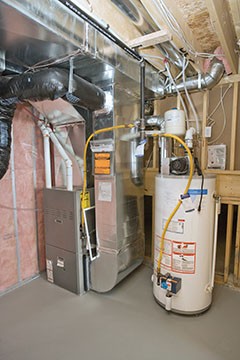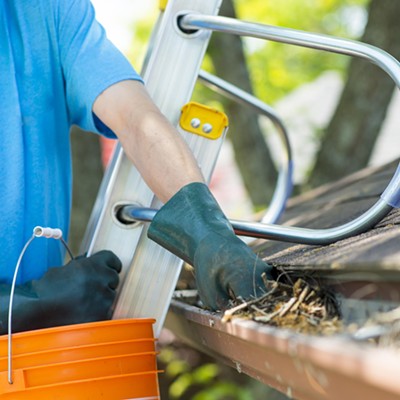Flushing your water heater
[
{
"name": "Air - MedRect Combo - Inline Content 1",
"component": "11490391",
"insertPoint": "3",
"requiredCountToDisplay": "1",
"parentWrapperClass": "fdn-ads-inline-content-block"
},{
"name": "Air - MedRect Combo - Inline Content 2",
"component": "11490392",
"insertPoint": "7",
"requiredCountToDisplay": "5",
"parentWrapperClass": "fdn-ads-inline-content-block"
},{
"name": "Air - MedRect Combo - Inline Content 3",
"component": "11490393",
"insertPoint": "12",
"requiredCountToDisplay": "9",
"parentWrapperClass": "fdn-ads-inline-content-block"
}
]
Much like changing your car’s oil, a water heater needs regular maintenance for top performance. A water heater flush clears out sediment and minerals such as calcium and lime, which could impede your heater’s performance.
Whether you have a gas or electric heater, sediment buildup represents a serious problem. Experts recommend that you drain and flush the tank once a year to keep it in good condition and extend its life. Fall is a good time to flush the tank if you haven’t done so already. You can expect to pay between $100 and $200 if you hire a professional for this service.
Tankless water heaters also benefit from cleaning and flushing. Although they don’t carry the same large amount of water as traditional tanks, scaling and sediment can build up in the pipes. This does take a bit longer than on a traditional tank, so you’ll be paying closer to the $200 end of the scale.
What happens if I don’t flush my water heater?
The sediment buildup insulates the water from the heat source on the bottom of the tank, which forces the heater to work harder. As a result, the heater requires more time and energy to heat the same amount of water.
If you leave sediment buildup untouched, it can create worse problems in the long term. Water pressure will drop, and pipes can burst. If sediment builds up high enough, it can shut down the tank entirely.
The harder your water, the more likely you’ll need a frequent flush. Hard water deposits more sediment than soft water. A noisy water heater is a sure sign of sediment buildup.
How can I flush my water heater?
You can drain your water heater yourself with no more tools than a garden hose, screwdriver and protective gloves. Take great care when coming in contact with the heater, pipes, and water - it will all be very hot!
1. Turn off the gas or electricity. The manufacturer’s instructions should explain this. Turn the gas control knob to the “pilot” position on a gas heater. For an electric heater, turn off the circuit breaker and disconnect the power supply.
2. Turn off the water supply valve.
3. Turn on the hot water faucet on a nearby sink, and keep it running while you work. This will prevent a vacuum from forming in the lines.
4. Attach your hose to the drain valve. Run it to a drain, driveway or empty bucket. You might need a manual pump if the water heater is in the basement.
5. Open the drain valve with a screwdriver. Allow the water to flow until it stops. If you’re using a bucket, be prepared to empty it frequently.
6. Open and close the water supply valve several times to stir up and flush the lingering sediment. The water will flow quickly, so be ready.
7. Disconnect the hose and close the drain valve tightly.
8. Open the water supply valve. Turn on hot water faucets on all your fixtures to remove air bubbles.
9. Follow manufacturer’s instructions to restart your heater. Make sure the tank is full, or else you may damage the heating element.
If you run into trouble at any point, contact a licensed plumber.
Whether you have a gas or electric heater, sediment buildup represents a serious problem. Experts recommend that you drain and flush the tank once a year to keep it in good condition and extend its life. Fall is a good time to flush the tank if you haven’t done so already. You can expect to pay between $100 and $200 if you hire a professional for this service.
Tankless water heaters also benefit from cleaning and flushing. Although they don’t carry the same large amount of water as traditional tanks, scaling and sediment can build up in the pipes. This does take a bit longer than on a traditional tank, so you’ll be paying closer to the $200 end of the scale.
What happens if I don’t flush my water heater?
The sediment buildup insulates the water from the heat source on the bottom of the tank, which forces the heater to work harder. As a result, the heater requires more time and energy to heat the same amount of water.
If you leave sediment buildup untouched, it can create worse problems in the long term. Water pressure will drop, and pipes can burst. If sediment builds up high enough, it can shut down the tank entirely.
The harder your water, the more likely you’ll need a frequent flush. Hard water deposits more sediment than soft water. A noisy water heater is a sure sign of sediment buildup.
How can I flush my water heater?
You can drain your water heater yourself with no more tools than a garden hose, screwdriver and protective gloves. Take great care when coming in contact with the heater, pipes, and water - it will all be very hot!
1. Turn off the gas or electricity. The manufacturer’s instructions should explain this. Turn the gas control knob to the “pilot” position on a gas heater. For an electric heater, turn off the circuit breaker and disconnect the power supply.
2. Turn off the water supply valve.
3. Turn on the hot water faucet on a nearby sink, and keep it running while you work. This will prevent a vacuum from forming in the lines.
4. Attach your hose to the drain valve. Run it to a drain, driveway or empty bucket. You might need a manual pump if the water heater is in the basement.
5. Open the drain valve with a screwdriver. Allow the water to flow until it stops. If you’re using a bucket, be prepared to empty it frequently.
6. Open and close the water supply valve several times to stir up and flush the lingering sediment. The water will flow quickly, so be ready.
7. Disconnect the hose and close the drain valve tightly.
8. Open the water supply valve. Turn on hot water faucets on all your fixtures to remove air bubbles.
9. Follow manufacturer’s instructions to restart your heater. Make sure the tank is full, or else you may damage the heating element.
If you run into trouble at any point, contact a licensed plumber.
Illinois Times has provided readers with independent journalism for almost 50 years, from news and politics to arts and culture.
Your support will help cover the costs of editorial content published each week. Without local news organizations, we would be less informed about the issues that affect our community..
Got something to say?
Send a letter to the editor and we'll publish your feedback in print!


























